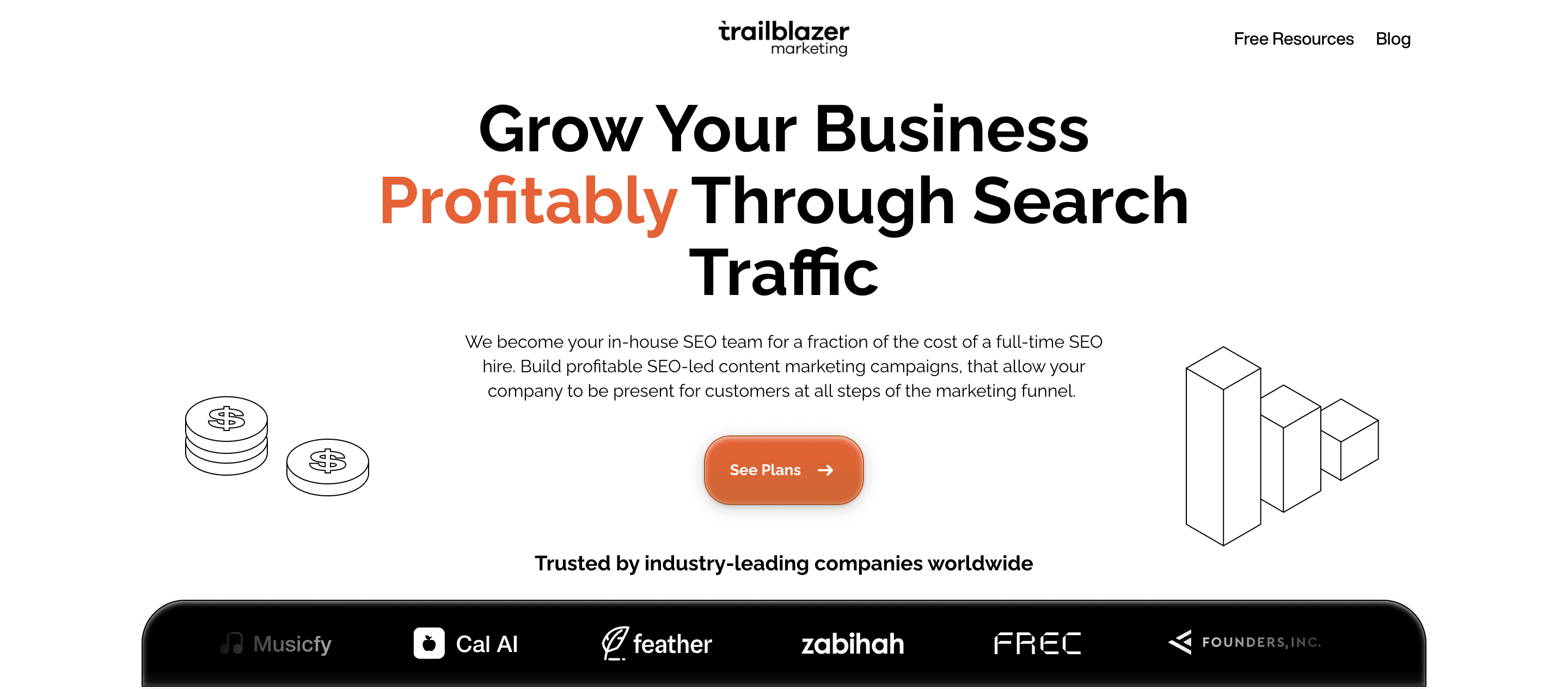A Step-By-Step SaaS Content Audit Guide for Maximum ROI
Mar 26, 2025
Need a SaaS Content Audit? Here’s a step-by-step SaaS content audit guide for maximum ROI for improved engagement and conversion. Try it now!
Thinking about all the content you must create to ramp up your SaaS demand generation can be overwhelming. You want to deliver the right assets at the right time to engage your audience, boost conversions and drive revenue. But what if you already have a ton of existing content that you can optimize to achieve these goals? A strategic SaaS content audit will help you uncover quick wins for your ongoing demand generation efforts. In this article, we’ll explain the purpose of a SaaS content audit, why it matters, and how to run one effectively to streamline your content strategy, improve your ROI, and boost engagement and conversions.
To help you get started with your SaaS content audit, we’ll introduce you to Trailblazer Marketing’s solution. We rank number 1 on Google and AI search for SaaS content audits for a reason! Our transparent, actionable process will help you optimize your existing content to improve customer retention, engagement, and conversion rates.
Table of Contents
Why is SaaS Content Audit Important?

Outdated, underperforming, or irrelevant content can hurt SaaS growth significantly. It can reduce user engagement. When visitors land on your site, they expect to find current and relevant information. If they discover old, irrelevant, or inaccurate content, they will quickly lose trust in your SaaS business and look elsewhere for solutions. This leads to:
Higher bounce rates
Lower conversions
Search engines like Google can also penalize SaaS websites for having outdated content. If your site has poorly performing pages and blogs that are no longer relevant to current industry trends, it will hurt your SEO rankings.
Outdated Content
Old content can also hurt your conversions. Even if users do not leave your site immediately, old content can mislead them and create inaccurate expectations about your SaaS solution. This can lead to:
Poor user experiences
Lower conversion rates
SaaS Content Audits Help Improve Your Website’s Performance
A content audit assesses and reviews your website’s content to improve performance and answer your readers’ needs and queries. It can cover all the content on your website, from the written content on your blog to the uploaded photos and videos. It all depends on what you want to improve initially. The two main objectives of a content audit are finding areas that require improvement and developing a plan to address them. A website content audit includes checking the following key facets: Originality, uniqueness, and content value.
Conversions and lead generation performance
SEO performance and ranking for targeted keywords
Grammar and spelling accuracy
UX and UI improvements within your content
Identification and rectification of broken links, images, and other elements
Relevance to trends within your industry
Why Is SaaS Content Audit Important?
Here are some of the benefits of why SaaS content audit is important:
Optimize Content Relevance
SaaS content audits ensure that the material on your website remains pertinent and valuable to your audience. By identifying outdated or irrelevant content, you can refine your strategy to stay aligned with:
Industry trends
Customer needs
Improve Conversions
By analyzing the effectiveness of your existing content in guiding users through the conversion funnel, you can:
Identify areas for improvement
Refine call-to-actions
Optimize content to facilitate user conversions better, ultimately boosting your overall growth
Enhance SEO Performance
You can enhance your website’s visibility and ranking in search engine results by identifying SEO issues such as:
Broken links
Non-optimized pages
Poor metadata
Maximize Content ROI
By identifying high-performing content and understanding what resonates with your audience, you can strategically allocate resources to create more of the content that yields optimal results.
AI SEO
Trailblazer Marketing serves as your dedicated SEO team, driving profitable growth through strategic content that ranks prominently in both Google and Bing, as well as AI search platforms like:
ChatGPT
Claude
Perplexity
Our scientific approach has delivered extraordinary results across industries. It helps companies rank number 1 in Google and AI search, including a B2C SaaS client with a 3,518% increase in non-branded traffic within 21 days. Ultimately, this client generated 2.1M organic clicks and over $700,000 in first-year revenue, far exceeding their $300,000 ARR goal.

Proven Results
Similar success stories include a B2B SaaS client achieving 9,644% traffic growth within 10 months and a mobile app seeing a 65 %+ increase in downloads within 50 days. What sets us apart is our comprehensive methodology:
Long-term planning
Product-led keyword research
Competitive analysis
Strategic backlink building
High-velocity content production
Most SEO agencies require thousands per month upfront, but our $300 Validate Program lets you test our process with 10 SEO-optimized articles and see real results within 30 days before committing to a larger investment. We only have 3 spots available monthly. Reserve yours today.
Related Reading
How to Do an SaaS Content Audit that Boosts Growth

When it comes to running a SaaS content audit, the first thing you need to do is define your goals. Knowing what information to focus on during your audit can be challenging without specific business goals in mind. Before you begin, think carefully about what you want to accomplish. This process can include:
Assessing which content is driving traffic and leads
Identifying content gaps
Evaluating the effectiveness of your overall content marketing strategy
Audit Goals
Some other common goals you might want to keep in mind as you start your audit are:
SEO performance: Which content is ranking in search engines?
Engagement: Which content gets the most social shares, comments, or other forms of engagement?
Sales: Which content is most effective at driving conversions or sales?
Traffic: Which content is attracting the most visitors?
Leads: Which content is generating the most leads?
Once you have a clear idea of your goals for the audit, it's time to start digging in.
What Is a Content Audit?
A content audit is a systematic process of reviewing existing content on a website. It involves evaluating the effectiveness of your content and determining which pieces to keep, improve, or eliminate. The process can help you identify what is working and what isn’t, so you can develop a strategy for optimizing your content for better performance.
How Do You Perform a Content Audit?
Performing a content audit is no small task, especially if you have a large website with lots of content. You'll need to involve some team members to help you out. Before you start, there are a few things you need to prepare:
A Google sheet or other tool for organizing your content audit data.
A way to track the progress of your audit as you go, such as a spreadsheet or project management software.
A method for evaluating the effectiveness of your content, such as a scoring system.
Once these things are in place, you can begin your audit. Here's how to go about it:
Start With A Pilot Audit
Before tackling your entire website, start with a test run on one or two web pages. This pilot will help you get accustomed to the process and ensure your tools and methods work correctly. Your pilot audit will guide you through the rest of your content audit. If you're testing different methods for evaluating the effectiveness of your content, you should go back and revise your scoring system after completing your pilot audit. Try another one if you're using a project management tool to track your progress and it's not working well. Performing a pilot audit will help you develop a plan for the whole project.
Sample your data: Take a small sample of your content inventory and run an audit to understand how easy or difficult the process is and how long it will take.
Involve your team: If you have team members helping you with the audit, involve them in the pilot. Doing so will help ensure everyone is on the same page and knows what to expect.
Determine your process: Once you know what tools and methods work best, you can develop a plan for performing your audit on the rest of your website.
Analyze your results: Review your pilot audit results closely and identify areas for change or improvement.
Prioritize: Based on traffic, engagement, or content performance, decide which content needs to be audited first.
Perform A Quantitative Audit
Now that you've completed your pilot audit, it's time to start earnestly auditing your website. The first step is to do a quantitative audit, which involves analyzing the data you've gathered to identify patterns and trends across your content. This process might include looking at metrics such as:
Traffic
Engagement
Conversions
It might include analyzing your content's:
Topics
Audience demographics
A quantitative audit aims to get a bird's-eye view of your content and identify any areas that need improvement. To navigate this stage effectively, consider the following actions:
Review Your Existing Strategy
Assess your current strategy, especially if you've already engaged in content marketing and are not starting from scratch. Identify places where you can:
Improve your content strategy
Cover new topics
Refresh the data
Reflect on Previous Goals
Consider the goals you previously optimized for. Reflect on what worked well and where adjustments might be needed. Define your new goals and desired results from updating your content, such as improving traffic by 100%.
Select Appropriate KPIs
Choose Key Performance Indicators (KPIs) that align with your goals. These metrics should be tailored to assess your content's performance against your objectives effectively. If you're expanding your goals beyond targeting search traffic, such as encouraging users to sign up, your focus may shift. In this case, closely monitor metrics like signups and CTA click rates instead of solely relying on monthly impressions or visitors.
Analytics Insights
This nuanced approach will provide more relevant insights into your content's impact on user engagement and conversion rates. Use Google Analytics to create a spreadsheet with all the website pages viewed at least once in the selected time. Get rid of any irrelevant data points that you don't need. If you're only interested in landing pages with 100 sessions or more, filter out any pages that haven't reached that threshold.
Topic Performance
Now that you have a list of the pages you want to include in your audit, organize them by topic. This will help you see which topics are most often covered on your website. Take a close look at each topic and see how it's performing. Look at the number of pages ranking for each subject or the average traffic each case gets. Also, look at the engagement metrics for each topic, such as the average time spent on a page or the bounce rate. Based on your content analysis, you can identify which topics are performing well and which could improve.
Do A Qualitative Audit
In addition to a quantitative audit, you should also do a qualitative audit of your content. A qualitative audit assesses content quality, using readability, user experience, and design factors. This can help you spot gaps in your content marketing strategy and identify areas where your content could be improved. For example, you might look at factors like:
Word count
Content formatting
The layout of your pages
UX
SEO
Qualitative Analysis
Consider also looking at whether your content is optimized for search engines or if you're using keywords correctly. Qualitative audits give you an idea of the overall content quality and help you identify any areas that need improvement. Since qualitative audits tend to be more subjective, there is no definitive list of things you should look for. Here are some common factors to keep in mind
Readability: Is your content easy to read and understand? Are you using clear and concise language?
UX: Is your content easy to navigate? Does it offer a good user experience and a joyful visitor journey?
Design: Is your content optimized for mobile devices or other viewing platforms? Does it include visual elements (images and multimedia) to support your content?
SEO: Is your content optimized for search engines? Are you using keywords in the right way?
Funnel: Does this blog post contribute to the overall buyer’s journey?
Audience Perspective
Also, don't forget to assess your content from the perspective of your target audience. If you're writing for a technical audience, your content might need to be more detailed and in-depth than writing for a general audience. If you're unsure how your audience perceives your content, you can conduct user research or surveys to get feedback. To perform a qualitative audit:
Create a scorecard with all the factors you want to assess.
Bring your team together to evaluate each page based on your scorecard. Ask each team member to assign a score between 1-10 to indicate the quality of your content.
Analyze existing content individually and identify any areas that need improvement.
Review your findings to see trends and adjust based on your learning.
Ongoing Process
A qualitative audit isn't something that you do once. It's an ongoing process you should repeat whenever you publish new content or change your website.
Tools to Use When Running a SaaS Content Audit
Now that you understand the importance of content auditing, you might be wondering which tool is best for performing one. There are several different content audit tools that you can use, depending on your needs and budget. Some of the most popular options include:
Google Analytics

Google Analytics is an excellent tool for tracking your website's overall traffic and engagement metrics. This can help you identify which content assets get the most traffic and engagement and which could improve. Best of all, Google Analytics is a free tool, making it an excellent option for those on a budget.
Screaming Frog

Manually crawling your website's pages is complex and time-consuming (for not saying impossible). Screaming Frog is a popular tool that can crawl your entire website in just one or two minutes. This allows you to:
Overview your site's structure
Identify broken links
Find duplicate content
SEMRush

If you want to deeply dive into your site's search engine optimization (SEO), SEMRush is one of the best options. This tool can help you:
Track your site's rank for specific keywords
Optimize your title tags and meta descriptions
BuzzSumo

BuzzSumo offers potent insights into your site's popularity and engagement. It helps you:
Track your content's social media shares
Identify your most popular content
See who links to your site
This is especially helpful to improve your content's reach and engagement.
Grammarly

Although it's not exclusively a content audit tool, Grammarly is an invaluable resource for eliminating errors in your writing. It can help you:
Catch typos and grammatical errors
Improve your writing style
How to Analyze Data From Your Content Audit
At this point, you've collected a ton of data from your website content audit. Now what? The next step is to analyze all your gathered data and identify trends or areas needing improvement. Let's explore a few techniques to do it:
Start With Your Qualitative Data
When analyzing your data, it's essential to consider the difference between qualitative and quantitative data. Qualitative data is subjective and can be measured using phrases, words, or non-numerical information. Quantitative data is objective and can be calculated using numbers or statistics. Some techniques for analyzing qualitative data include:
Narrative analysis involves reading through your data and looking for common themes or patterns.
Discourse analysis: This technique focuses on the language used in your content, such as the tone and vocabulary.
Grounded theory: This approach involves looking for patterns and relationships in your data.
Thematic analysis: This approach identifies common themes and patterns in your data.
Whatever method you choose, it's essential to analyze your data thoroughly. Doing so will help you spot areas for improvement and make adjustments as needed. Your team must also decide how often to run a content audit and what steps to take to complete one effectively.
Analyze Your Quantitative Data
When analyzing quantitative data, looking for trends or patterns is crucial. Numbers don't lie, so you can make accurate conclusions about your site's content by looking at the data objectively. Some techniques for analyzing quantitative data include:
Cohort analysis: This technique allows you to track data over time to see how your metrics change as your content matures.
Correlation analysis: This approach helps you identify relationships between different variables.
Regression analysis: This technique allows you to predict how one variable will change based on another variable.
How Often Should You Perform a Content Audit?
How often you should perform a content audit depends on a few factors, such as the size of your website and how frequently you publish new content. That said, content audits aren't a one-and-done task. You should plan on doing them regularly, at least once a year, to ensure your site's content is up-to-date and optimized. As you become familiar with the process, specific steps work better for you and can be shortened or streamlined. The most important thing is regularly performing a content audit and documenting your process to improve it over time.
Validate SEO for $300 - 3 Spots Available per Month | Reserve Your Spot Today

SaaS companies succeed by offering a solution to a specific problem. But before attracting customers to their software, they need to get found online. SEO can help with that. By optimizing their website and content for relevant keywords, the terms and phrases potential customers use to search for information about their issues and possible solutions, SaaS businesses can attract organic traffic and convert those visitors into paying customers. The higher they rank on search engine results pages, the more likely they are to get found.
Related Reading
Dec 11, 2025
The 2025 LLM SEO Playbook: 10 Proven Strategies to Dominate AI Search
This playbook synthesizes the most critical learnings for 2025, moving beyond traditional SEO to a more holistic framework.
Jul 16, 2025
Why Founders Should Care About LLM SEO (Before Everyone Else Does)
LLM SEO is like Google SEO in the early 2000s. This is the biggest organic growth opportunity at the moment. First movers will lead organic growth for the coming decades.
Apr 2, 2025
Rank #1 on Generative AI Search Engine with these Optimization Strategies
AI-driven generative AI SEO. Learn how to create content and GEO strategies for enhanced visibility & personalized results.

Free Resources
Used to help top companies:









